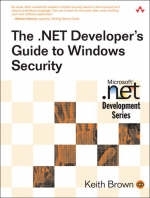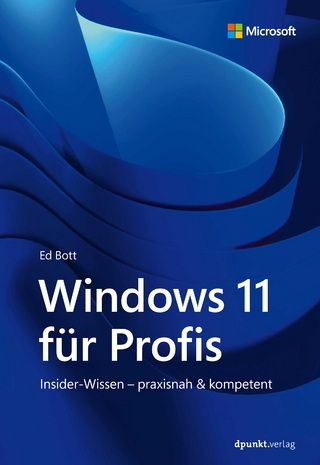
The .NET Developer's Guide to Windows Security
Addison-Wesley Educational Publishers Inc (Verlag)
978-0-321-22835-2 (ISBN)
- Titel ist leider vergriffen;
keine Neuauflage - Artikel merken
"As usual, Keith masterfully explains complex security issues in down-to-earth and easy-to-understand language. I bet you'll reach for this book often when building your next software application."
--Michael Howard, coauthor, Writing Secure Code
"When it comes to teaching Windows security, Keith Brown is 'The Man.' In The .NET Developer's Guide to Windows Security, Keith has written a book that explains the key security concepts of Windows NT, Windows 2000, Windows XP, and Windows Server 2003, and teaches you both how to apply them and how to implement them in C# code. By organizing his material into short, clear snippets, Brown has made a complicated subject highly accessible."
--Martin Heller, senior contributing editor at Byte.com and owner of Martin Heller & Co.
"Keith Brown has a unique ability to describe complex technical topics, such as security, in a way that can be understood by mere mortals (such as myself). Keith's book is a must read for anyone attempting to keep up with Microsoft's enhancements to its security features and the next major version of .NET."
--Peter Partch, principal software engineer, PM Consulting
"Keith's book is a collection of practical, concise, and carefully thought out nuggets of security insight. Every .NET developer would be wise to keep a copy of this book close at hand and to consult it first when questions of security arise during application development."
--Fritz Onion, author of Essential ASP.NET with Examples in C#
The .NET Developer's Guide to Windows Security is required reading for .NET programmers who want to develop secure Windows applications. Readers gain a deep understanding of Windows security and the know-how to program secure systems that run on Windows Server 2003, Windows XP, and Windows 2000.
Author Keith Brown crystallizes his application security expertise into 75 short, specific guidelines. Each item is clearly explained, cross-referenced, and illustrated with detailed examples. The items build on one another until they produce a comprehensive picture of what tools are available and how developers should use them.
The book highlights new features in Windows Server 2003 and previews features of the upcoming version 2.0 of the .NET Framework. A companion Web site includes the source code and examples used throughout the book.
Topics covered include:
Kerberos authentication
Access control
Impersonation
Network security
Constrained delegation
Protocol transition
Securing enterprise services
Securing remoting
How to run as a normal user and live a happy life
Programming the Security Support Provider Interface (SSPI) in Visual Studio.NET 2005
Battle-scarred and emerging developers alike will find in The .NET Developer's Guide to Windows Security bona-fide solutions to the everyday problems of securing Windows applications.
Keith Brown focuses on application security at Pluralsight, which he cofounded with several other .NET experts to foster a community, develop content, and provide premier training. Keith regularly speaks at conferences, including TechEd and WinDev, and serves as a contributing editor and columnist to MSDN Magazine.
Preface.
Acknowledgments.
I: THE BIG PICTURE.
Item 1: What Is Secure Code?
Item 2: What Is a Countermeasure?
Item 3: What is threat Modeling?
Item 4: What Is the Principle of Least Privilege?
Item 5: What Is the Principle of Defense in Depth?
Item 6: What Is Authentication?
Item 7: What Is a Luring Attack?
Item 8: What Is a Nonprivileged User?
Item 9: How to Develop Code as a Non-Admin.
Item 10: How to Enable Auditing.
Item 11: How to Audit Access to Files.
II: SECURITY CONTEXT.
Item 12: What Is a Security Principal?
Item 13: What Is a SID?
Item 14: How to Program with SIDs.
Item 15: What Is Security Context?
Item 16: What Is a Token?
Item 17: What Is a Logon Session?
Item 18: What Is a Window Station?
Item 19: What Is a User Profile?
Item 20: What Is a Group?
Item 21: What Is a Privilege?
Item 22: How to Use a Privilege.
Item 23: How to Grant or Revoke Privileges via Security Policy.
Item 24: What Are WindowsIdentity and WindowsPrincipal?
Item 25: How to Create a WindowsPrincipal Given a Token.
Item 26: How to Get a Token for a User.
Item 27: What Is a Daemon?
Item 28: How to Choose an Identity for a Daemon.
Item 29: How to Display a User Interface from a Daemon.
Item 30: How to Run a Program as Another User.
Item 31: What Is Impersonation?
Item 32: How to Impersonate a User Given Her Token.
Item 33: What is Thread.CurrentPrincipal?
Item 34: How to Track Client Identity Using Thread.CurrentPrincipal.
Item 35: What Is a Null Session?
Item 36: What Is a Guest Logon?
Item 37: How to Deal with Unauthenticated Clients.
III: ACCESS CONTROL.
Item 38: What Is Role-Based Security?
Item 39: What Is ACL-Based Security?
Item 40: What Is Discretionary Access Control?
Item 41: What Is Ownership?
Item 42: What Is a Security Descriptor?
Item 43: What Is an Access Control List?
Item 44: What Is a Permission?
Item 45: What Is ACL Inheritance?
Item 46: How to Take Ownership of an Object.
Item 47: How to Program ACLs.
Item 48: How to Persist a Security Descriptor.
Item 49: What Is Authorization Manager?
IV: COM(+) AND ENTERPRISESERVICES.
Item 50: What Is the COM(+) Authentication Level?
Item 51: What Is the COM(+) Impersonation Level?
Item 52: What Is CoInitializeSecurity?
Item 53: How to Configure Security for a COM(+) Client.
Item 54: How to Configure the Authentication and Impersonation Levels for a COM+ Application.
Item 55: How to Configure the Authentication and Impersonation Level for an ASP.NET Application.
Item 56: How to Implement Role-Based Security for an Enterprise Services Application.
Item 57: How to Configure Process Identity for a COM(+) Server Application.
V: NETWORK SECURITY.
Item 58: What Is CIA?
Item 59: What Is Kerberos?
Item 60: What Is a Service Principal Name (SPN)?
Item 61: How to Use Service Principal Names.
Item 62: What Is Delegation?
Item 63: What Is Protocol Transition?
Item 64: How to Configure Delegation via Security Policy.
Item 65: What Is SSPI?
Item 66: How to Add CIA to a Socket-Based App Using SSPI.
Item 67: How to Add CIA to .NET Remoting.
Item 68: What Is IPSEC?
Item 69: How to Use IPSEC to Protect Your Network.
VI: MISCELLANEOUS.
Item 70: How to Store Secrets on a Machine.
Item 71: How to Prompt for a Password.
Item 72: How to Programmatically Lock the Console.
Item 73: How to Programmatically Log Off or Reboot the Machine.
Item 74: What Is Group Policy?
Item 75: How to Deploy Software Securely via Group Policy.
Bibliography.
Index.
| Erscheint lt. Verlag | 7.10.2004 |
|---|---|
| Verlagsort | New Jersey |
| Sprache | englisch |
| Maße | 180 x 234 mm |
| Gewicht | 778 g |
| Themenwelt | Informatik ► Betriebssysteme / Server ► Windows |
| Informatik ► Theorie / Studium ► Kryptologie | |
| ISBN-10 | 0-321-22835-9 / 0321228359 |
| ISBN-13 | 978-0-321-22835-2 / 9780321228352 |
| Zustand | Neuware |
| Haben Sie eine Frage zum Produkt? |
aus dem Bereich


